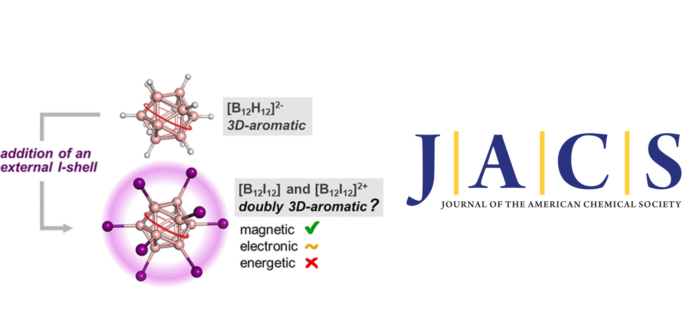3D-aromatic compounds are scarce. The first known species with 3D-aromaticity were the closo boranes, such as [B10H10]2- or [B12H12]2- and derivatives. Not only closo boranes, but also carboranes, which result from single or double substitution of BH by isoelectronic CH+ units in closo boranes, are 3D-aromatic compounds. Apart from closo (car)boranes, fullerenes in certain spin and charge states and Zintl phases are other known 3D-aromatic compounds. On the other hand, doubly 3D-aromatic species are unknown.
In this work, we describe the experimental 11B{1H} NMR spectra of iodinate derivatives that result from the stepwise substitution of hydrogen atoms by iodine atoms in the neutral o-carborane (1,2-C2B10H12). These NMR spectra allows us to conclude the existence of I···I non-covalent interactions in substituted boron-iodinated o-carboranes (In-1,2-C2B10H12-n, n=1-10). The existence of such interactions in periodinated o-carboranes together with the well-known double 2D-aromaticity of C6I6+2 and related species, lead us to wonder whether it would be possible to generate doubly 3D-aromatic species by oxidation of [B12I12]2- to generate [B12H12] and [B12H12]2+. Magnetic properties of [B12H12]0/2+ species indicate that these two oxidized forms of closo icosahedral dodecaiodo-dodecaborate cluster behave as doubly 3D-aromatic compounds. Analysis of the electronic properties of [B12I12]0/2+ reveals an increase in delocalization within the iodine shell, yet it proves insufficient to fully support double 3D-aromaticity. Finally, an estimation of the energetic contribution of the potential double 3D-aromaticity through homodesmotic reactions shows that delocalization in the I12 shell, in contrast to the I6 ring in the hexaiodidebenzene dication, does not contribute to any stabilization of the system. Therefore, our conclusion is that the [B12I12]0/2+ species cannot be considered as doubly 3D-aromatic.
This work has been carried out by Prof. Jordi Poater from the University of Barcelona, Prof. Francesc Teixidor and Prof. Clara Viñas from the Institute of Material Science (CSIC, Bellaterra), Prof. Henrik Ottosson from Uppsala University, and Sílvia Escayola, Dr. Albert Poater, and Prof. Miquel Solà from the DiMoCat group of the Institute of Computational Chemistry and Catalysis of the University of Girona.
It has been recently published open access in Journal of the American Chemical Society:
A. Poater, S. Escayola, A. Poater, F. Teixidor, H. Ottosson*, C. Viñas* and M. Solà*.
“Single – not double – 3D-aromaticity in oxidized closo icosahedral dodecaiodo-dodecaborate cluster.“
J. Am. Chem. Soc., 2023, ASAP
DOI: 10.1021/jacs.3c07335
Girona, September 28, 2023
For more info: ges.iqcc@udg.edu

